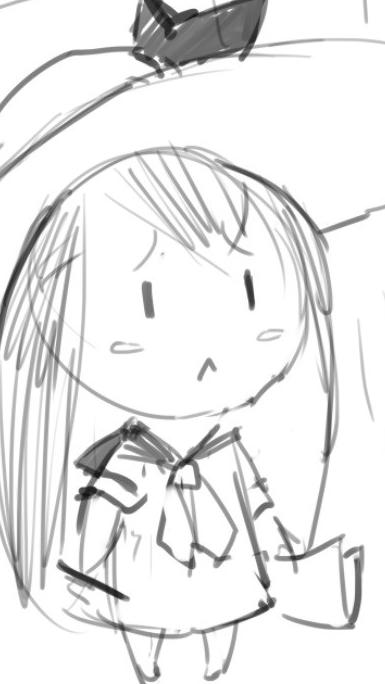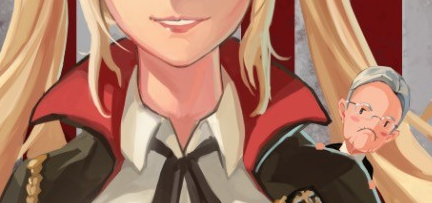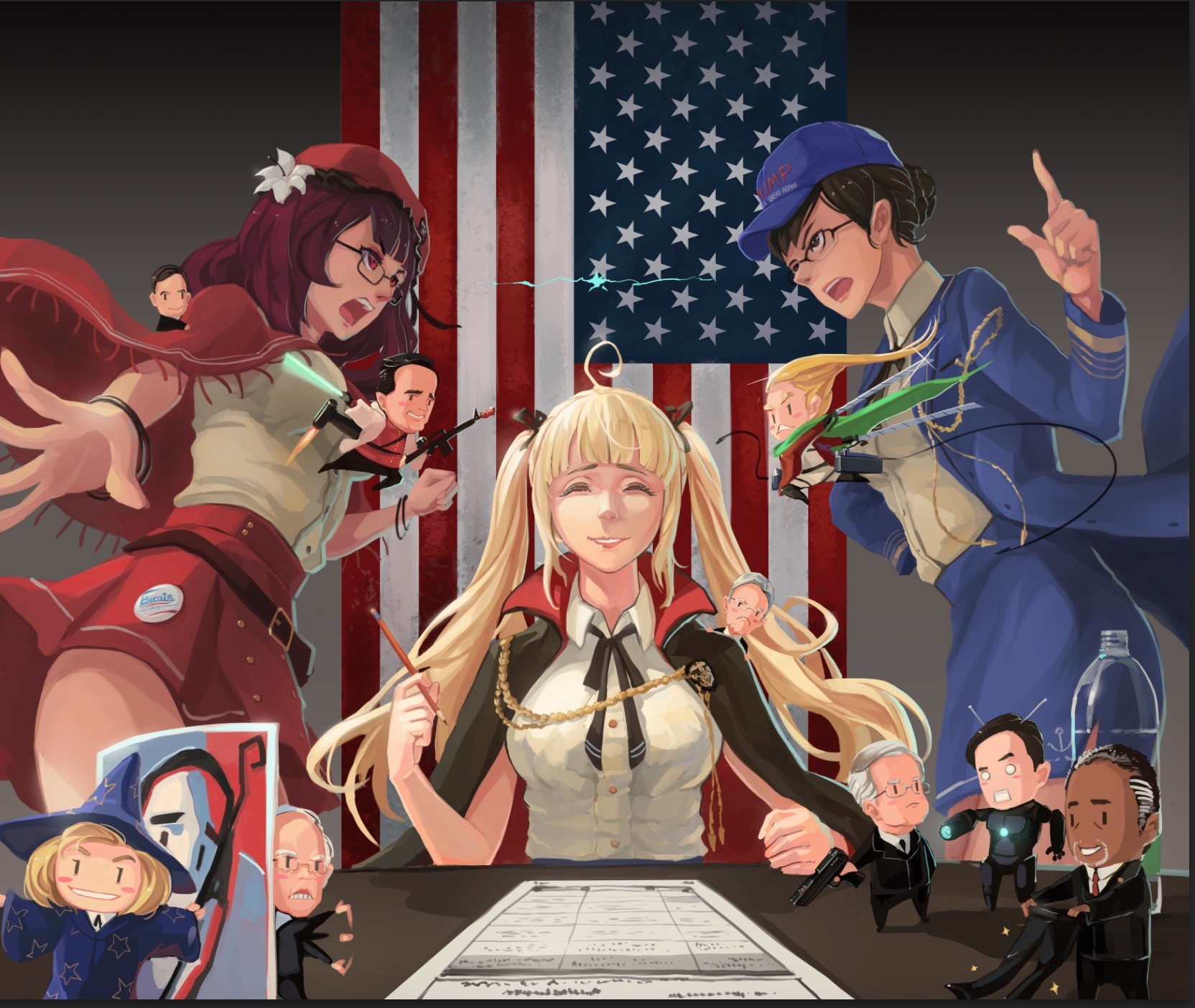Close one, guys. Real close on the left side. Bernie was losing by twenty points the week before and I think he did good. 47.3% to 52.6%.
这个够险的,伙计们。真的,左边很险哦。老爷子一个星期前落后将近20多分呢,这次我感觉他干的不错。以47.3%输给希拉里的52.6%。
Now, the right side?
右边嘛…
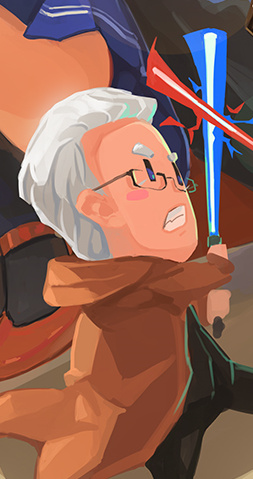
“What happened, —–? You were supposed to be the chosen one! You were to unite the base, not fracture it even further! Half of them are going for —- or —– now!”
“怎么会这样,- – -? 你本来应当是被拣选者,是救世主!你本当统一我们的选民,而不是让他们四分五裂!现在他们一半都去投 – – – 或者 – – 啦!”
“YOU’RE-LOW-ENERGY, MASTER —-! STAND-ASIDE. I-WILL-DEFEAT-THE-DEMOCRATS-BECAUSE-I-AM-MOST-ELECTABLE.WHEN-THIS-RACE-IS-OVER-I-WILL-BE-THE-ONE-TO-BRING-PEACE-JUSTICE-FREEDOM-AND-SECURITY-TO-ALL-OF-THE-GOP.”
“你-太-低-能-量-了,- – 大-师!给-我-让-开。我-会-打-败-民-主-党,因-为-我-在-普-选-中-的-机-率-是-最-大-的。这-场-初-选-结-束-后,我-会-给-所-有-共-和-党-人-民-带-来-和-平,正-义,自-由,以-及-安-全。
“The GOP? —–, our allegiance is to America, to the people, to democracy!”
“共和党?- – -,我们的任务以及忠诚是对美国,对美国人民,以及民主啊!”
“IF-YOU’RE-NOT-WITH-ME-THEN-YOU-ARE-MY-ENEMY.”
“如-果-你-不-支-持-我,那-你-就-是-我-的-敌-人。”
Lemme tell ya I’d never vote for either of ’em. But the bit that Jeb said as Jeb left? I can see why people liked the guy.
说句实话,这俩家伙我永远都不会投一票。但你知道布什走前说的那番话?我理解为什么有些人喜欢他了。
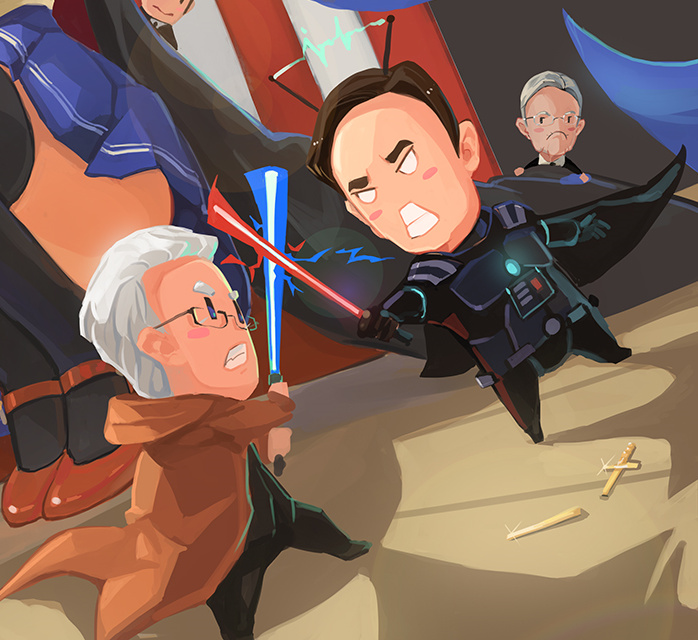
*Vrrrrrnnnnnnnn-Fzzzzrt!*
×声效:激光剑撞击声
“YOUR-SUPPORT-IS-WEAK-OLD-MAN.”
“老-家-伙,你-的-支-持-率-太-低-了。”
*Vvvvvvv -*
×声效:激光剑撞击声
“This isn’t winning, —–. If you strike me down and remove me from this race I shall become more powerful than you could ever imagine!”
“这不是胜利,- – -。如果你将我击倒,让我退出这场选举,我将变的比你想象的还要强大!”
Okay, breaking the fourth wall for a second. I shouldn’t hafta say this, but it’s PARODY. Like Iowa said, vote who you like. We ain’t endorsing anyone or telling you who you should be voting for.
稍微说一下哈。我真的不应该重复这一点。俺们这只是在闹玩。我们可没有想告诉你应该支持谁,也没想支持任何一个人。你爱投谁投谁。
Got that? Good. Hey! Tennsy! Okie! You two are up!
明白了吗?好样的。奥姬!田希,轮到你们俩了!
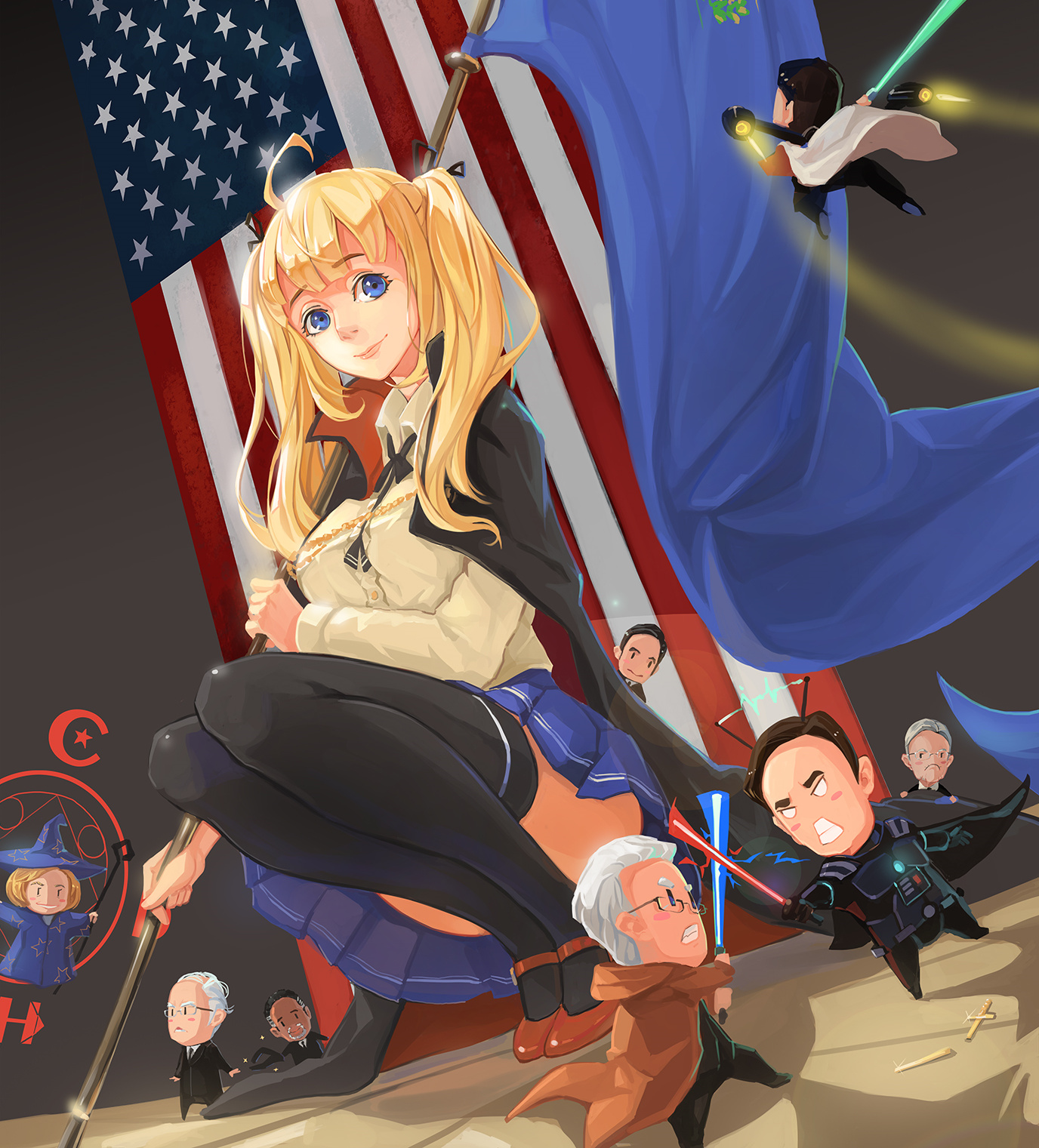
Hey guys. A not-so-quick note here from Morgane.
大家好。这次莫根有想说的话~
I’ve received a lot of positive feedback – far more so than I was expecting, and I really want to say thank you. The folks that are offended by how we’re choosing to depict your candidates, we’re sorry, but that’s how we (Sima and I) decided to depict them. I’m sure that “we mean no offense” won’t make you less offended, but I really do mean that. We mean no offense.
我收到了很多的反应,绝大多数都是正面的。并且这些反应超出了我的预料。谢谢你们哦。对于那几位因为看到自己支持者而不爽的读者,对不起,但我们没有任何侮辱他们人格的意思。我知道我这样说可能说服不了你们,但,真的就是这样。我们这样画他们是因为有梗啊以及好玩啊。
Now, this update’s commentary.
稍微解释下为什么这次更新选择这样画。
You guys may have noticed that the focus here was really on Rubio and Bush. That’s because I was seriously afraid that one of them would drop – and they did. Personally, I’m extremely upset at Bush’s departure. Not because I supported any of his policies (when NJ rolls around I’m definitely NOT going to write him in xD), but because he has so many funny quirks that makes him a fun, fun fairy to draw.
你们也许这次看到了我们注重的是水哥和小小灌木。这原因其实是因为我非常怕他们俩有其中一个人退出初选的。最后,我害怕的事情还是发生了。唉,我其实对小小灌木的退出很伤心。这不是因为我支持他(我肯定不会投这家伙一票的,放心吧),而是因为他有太多的各种奇葩梗,画成精灵会特别特别的乐哦。
Given that this’ll be the last time you see of Fairy!Jeb for a while, we thought to give him a sending-off that would be appropriate. Hence the focus here, and the conclusion we now see.
所以既然这是目前最后一次小精灵布什的出场,我想让他走的震撼点。所以呢,上面所有的梗的来源以及这次的作品都是为了这个的。
See, the NH primary gave me some downtime to seriously research the candidates, but I’ve always had an idea about how Bush vs Rubio might have turned out. They’ve been attacking each other in the media a whole lot, but it hadn’t always been that way.
NH的初选(因为没舰娘嘛)给了我一点休息的时间,能让我好好的研究下他们的各种属性。然而,在研究前我已经想好了水哥和小小灌木的梗。因为你知道现在他们俩在电视上各种互黑的广告实在太多了。
然而,你知道,他们之前并不是这样。
No, in fact? Bush handed Rubio the Sword of Chang, a legendary artifact that’s basically the Republican Caliburn/Excalibur. Yes, it’s the sword of conservatism, meant to represent the enduring light of republicanism (whatever that actually means). Here’s a story explaining it (from the HuffPo.) Here’s the interview where Rubio talks about it. Yes. It’s also what lies broken at the feet of the two Floridans. I’ll leave it to you to interpret the symbolism.
你知道当时他们曾经是很近的好友哦。小小灌木甚至赐给了水哥“张之剑,”就是美国共和党版本的石中剑/选王之剑/咖喱棒。对。这具神器是美国保守派的胜利之荣光(虽然我也不知道是啥意思啦!)
这把剑是真的。小小灌木真的在2005年公开赠给了水哥一把(我个人看起来感觉可能是中国制造的)剑。我上面那俩链接里一个是当时的镜头以及事后人的分析,一个是水哥自己的吐槽。
(水哥被问:这把剑到底象征什么?答:应该是象征各种各样的共和党价值吧。反正是一个叫做张的传说人物所持。理论上来说当共和党有需要的时候,他会出现拯救整个党派。
然后记者问:这到底是何方神话传统中冒出来的人物?水哥答:应该是杰布•布什自己脑洞出来的吧…)
对。画中被打断的那把剑,就是这把。我想你能看出来这里面的象征意义吧?
I know that this is real life, and obviously Bush and Rubio weren’t exactly straight-up mentor-mentee like Obi-Wan and Anakin. There are plenty of articles commenting on the nuances and the subtleties, plenty of opinions writing about ambitions, old blood, and politics.
我知道这是现实生活。小小灌木和水哥当然不是真正的师徒关系,也不可能有那么亲密。跟星战前传中的天行者(后来变的黑武士)和奥比万的关系也自然不同。如果你对这感兴趣的话,有不少文章在那边分析他们的性格啊,他们的相爱相杀啊等等等。
But isn’t it just deliciously ironic that the GOP favorite was undone by the upstart freshman senator that they’ve carefully groomed, trained, and cultivated? Am I the only one that sees similarities in Anakin’s actions during the prequels and Rubio’s circumvention of GOP norms and “rules” and choosing to run for president? Could Bush plausibly feel a hint of the same kind of mixture of emotions as Obi-wan return in Episode IV to fight Darth Vader?
但你不感觉共和党的置顶继承人(小小灌木)被自己一手带大的徒弟(水哥)干掉,是一件蛮有讽刺性的事情吗?我难道是唯一一个感觉水哥的逆袭跟阿纳金在第三部电影里的行为以及动机基本上吻合的天衣无缝吗?难道小小灌木在退出的时候,他的情感就完全跟第四部星战里奥比万对黑武士的不同吗?
We had to do it. It was far too good to pass up. And you know what? I honestly think Fairy!Jeb is partly right. Yes, Rubio took him down. It’s everything the GOP strategists are supposed to do. Winnow the field. Bring the crown home. Win.
这个梗脑洞开后就根本停不下来了。这个机会太棒了。这个梗太巧了。你知道吗?并且说句实话,我认为小精灵布什的话其实对了一半。没错,水哥最后确实打败了他。但这就是他应当做的。共和党需要减少候选人,才能有胜利的可能。每一个被撵出的候选人都表示你可以更快的接近皇冠。你可以更快的赢。
It’s what he should do. All the pundits say it. All the strategists say it. Ted Cruz and Ben Carson and John Kasich knows it.
他应该这么做。所有的军师都这么说。所有的记者都这么说。Cruz和卡森医生和州长也都知道。
But you know what? When Fairy!Jeb went out I don’t think it made him stronger. At least, not directly. He certainly left a good impression on the media, but … not analogous to Obi-Wan.
但你知道吗?小精灵布什错了。他被打倒后,他并没有变得“更强大。”他给媒体也许留了个好印象,但这个跟奥比万在电影里面最后能帮助主人公,是个完全两码事的问题。
No.
不。
In theory, the idea of the winnowing is basically this. For every candidate that leaves, their voters will go vote for someone – the “savior” or “chosen one” selected by the party elites. Looks like at the moment that chosen one is Marco Rubio, so the goal is to simply get all these unwashed masses to vote for him.
理论上来说,每当一个候选人退出时,他们的选民理论上会投奔那个被指定的“救世主,”就是党里面希望赢的人。目前来看这位很可能是水哥,马可•卢比奥。所以党派内部肯定要想办法把他推上台,让这帮贱民们只要好好去投他就好了。
What makes you think Jeb’s voters are just going to fall into line and vote Rubio?
但是,谁说小小灌木的选民民就一定要乖乖的排队开始给水哥投票呢?
I mean, let’s be honest here, who the hell do you think Cruz is jetpacking towards, anyways?
咱说句实话吧。你认为这画里面的Cruz到底是对谁开始了冲锋突击?

That’s right.
对啦。
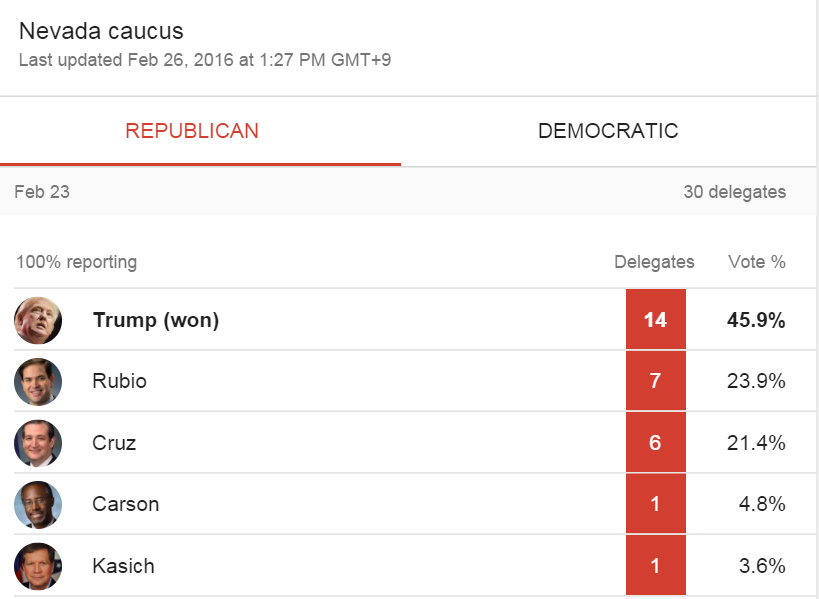
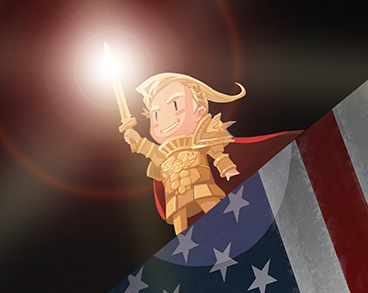
That’s right. Him.
就是他。
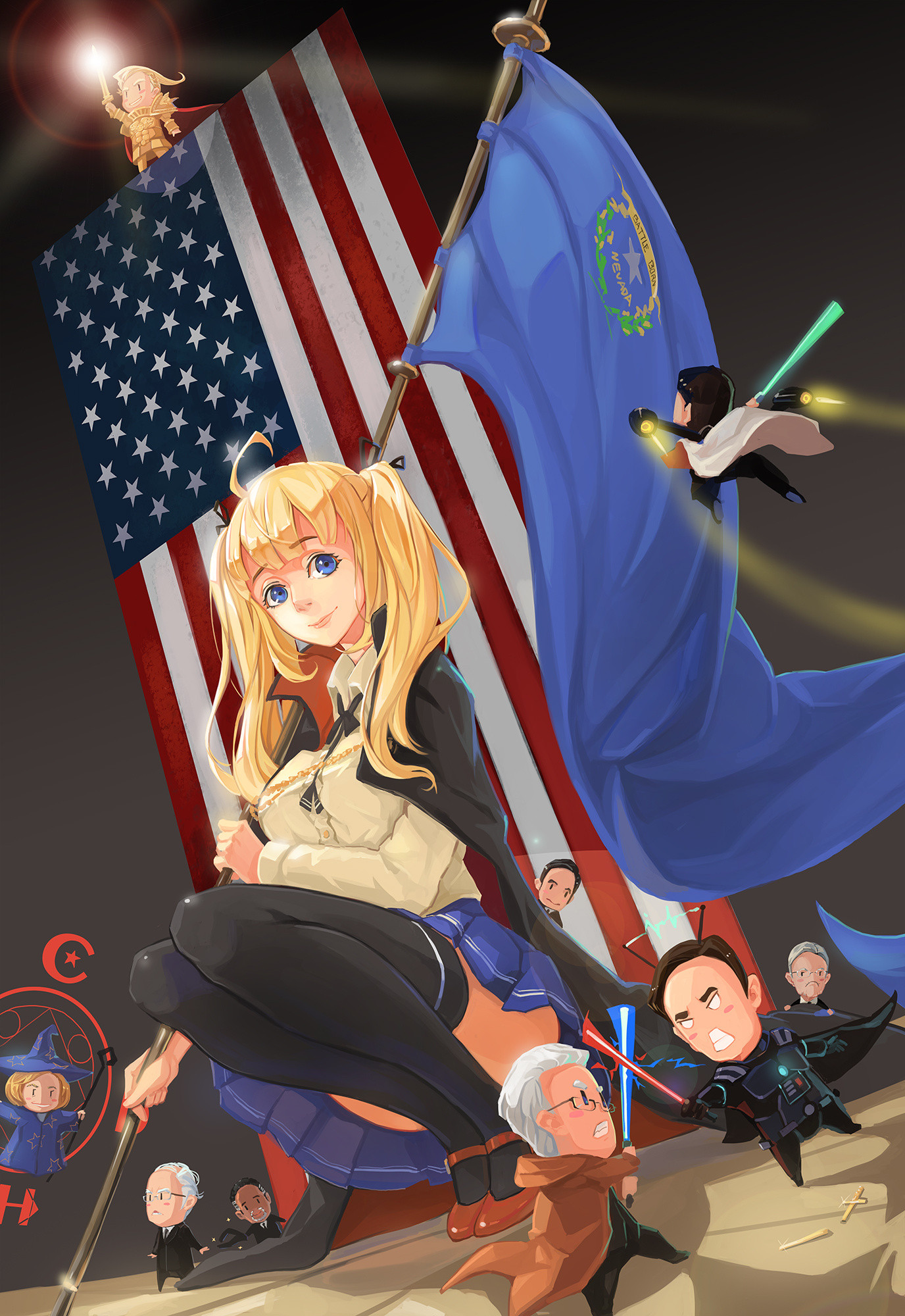
< The Nevada Primary with Nevada ◇ TIME LINE ◇ Super Tuesday! >


